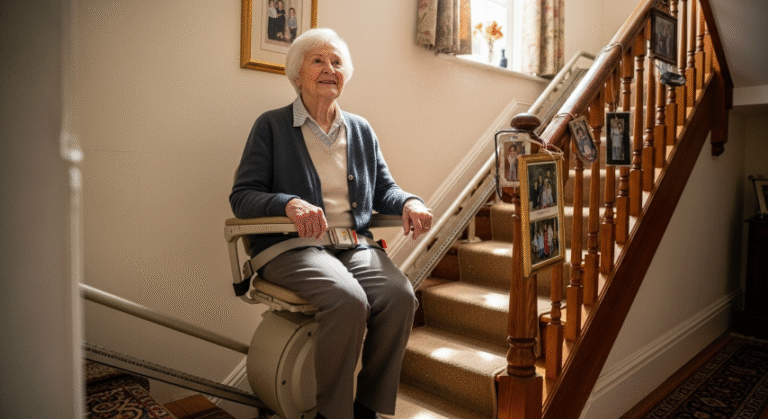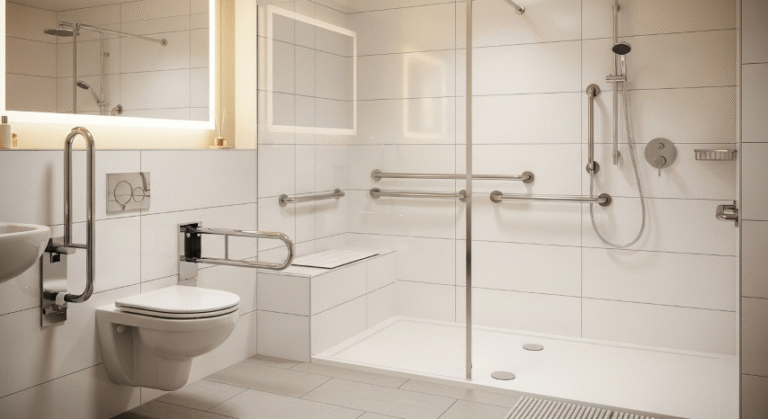How to Choose the Right Access Ramps for UK Senior Homes
Complete Safety & Independence Guide 2025
Executive Summary: UK Access Ramp Solutions 2025
According to recent accessibility studies, over 2.8 million UK households require mobility improvements, with access ramps being the most cost-effective solution for maintaining independence.
- Threshold ramps (£200-£800) – Ideal for doorway transitions and small steps
- Portable ramps (£300-£2,000) – Flexible solutions for temporary access needs
- Modular systems (£2,000-£8,000) – Customizable permanent installations
- Permanent concrete ramps (£3,000-£15,000) – Long-term accessibility solutions
Visual Guide: Access Ramp Types in UK Homes

Professional installation with safety railings and non-slip surface
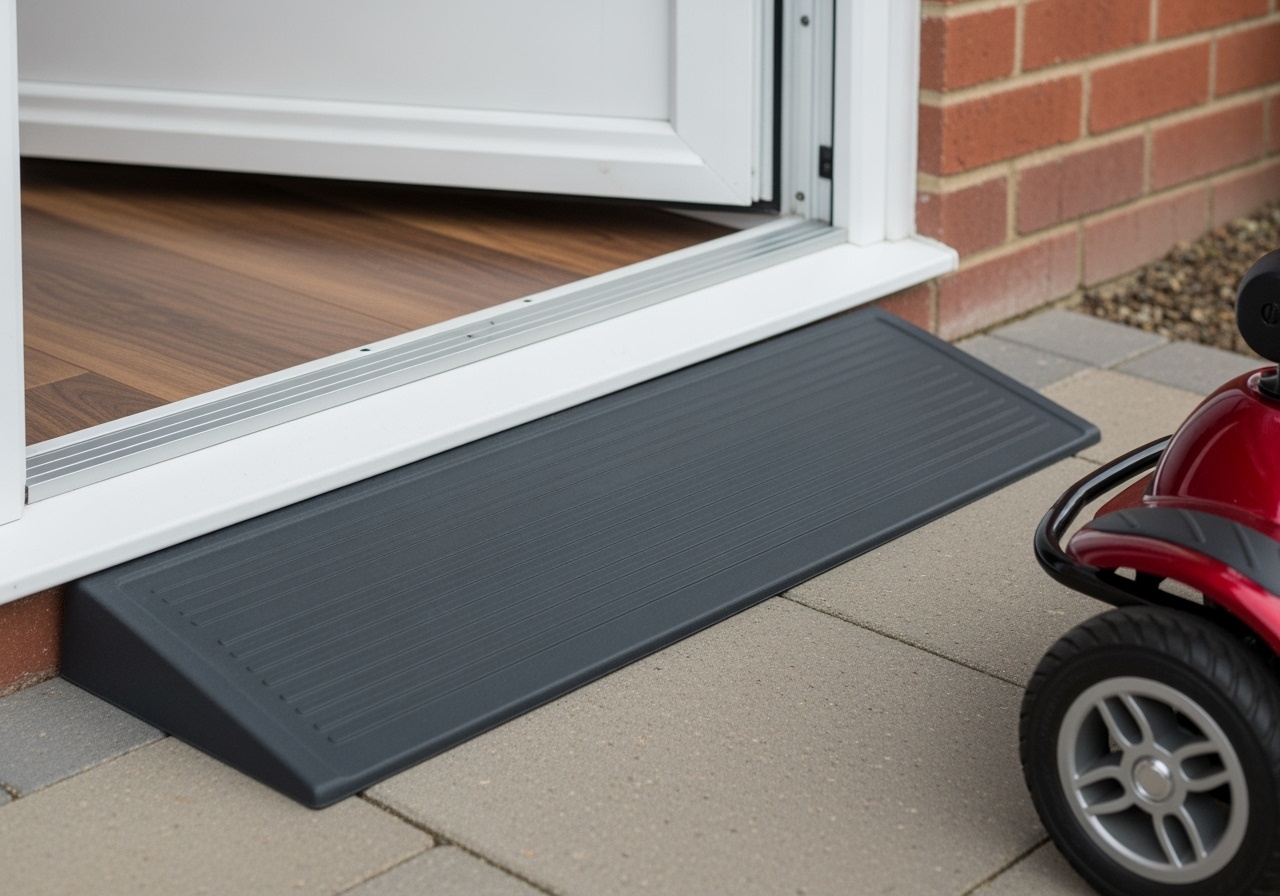
Low-profile solution for doorway transitions and small steps
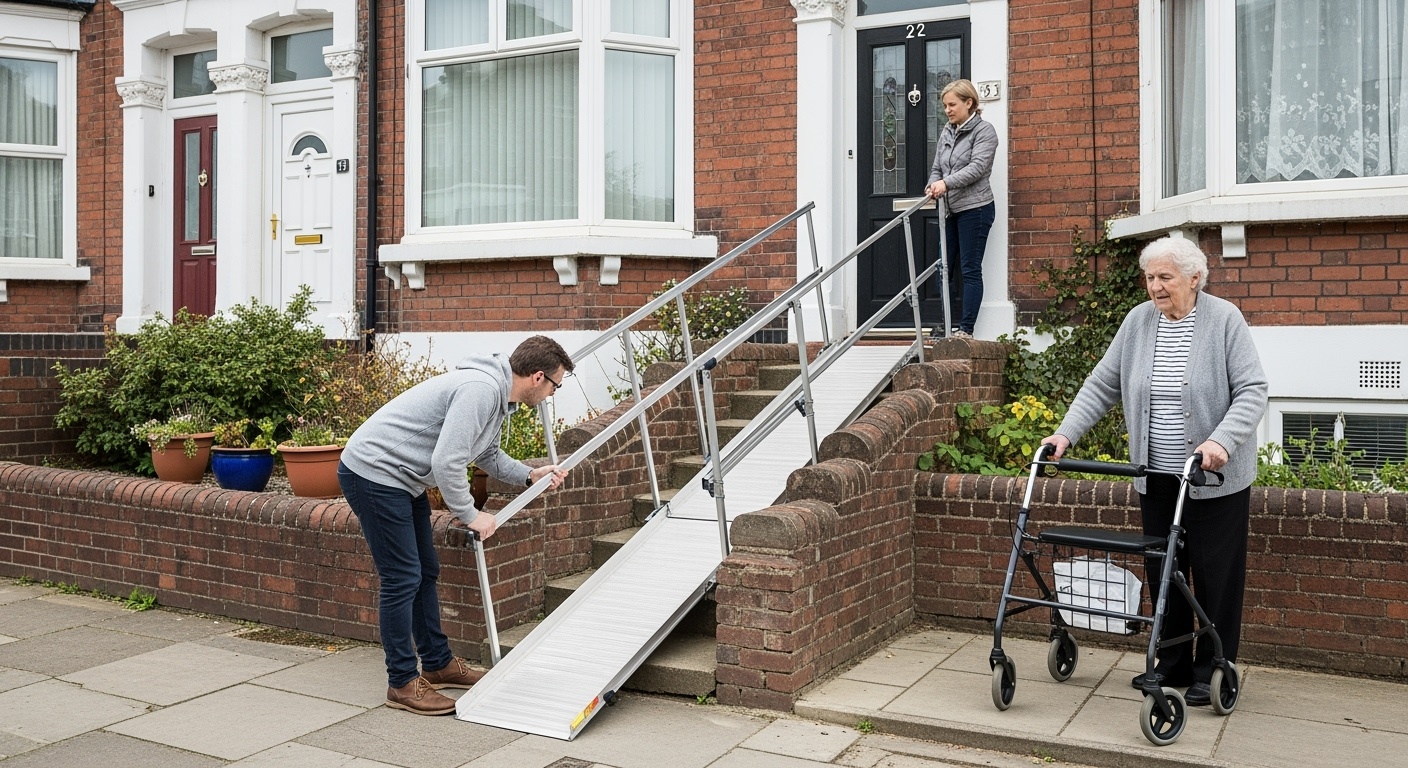
Lightweight aluminum solution for temporary access needs
Real UK Installations & Products

Professional modular ramp system with safety features
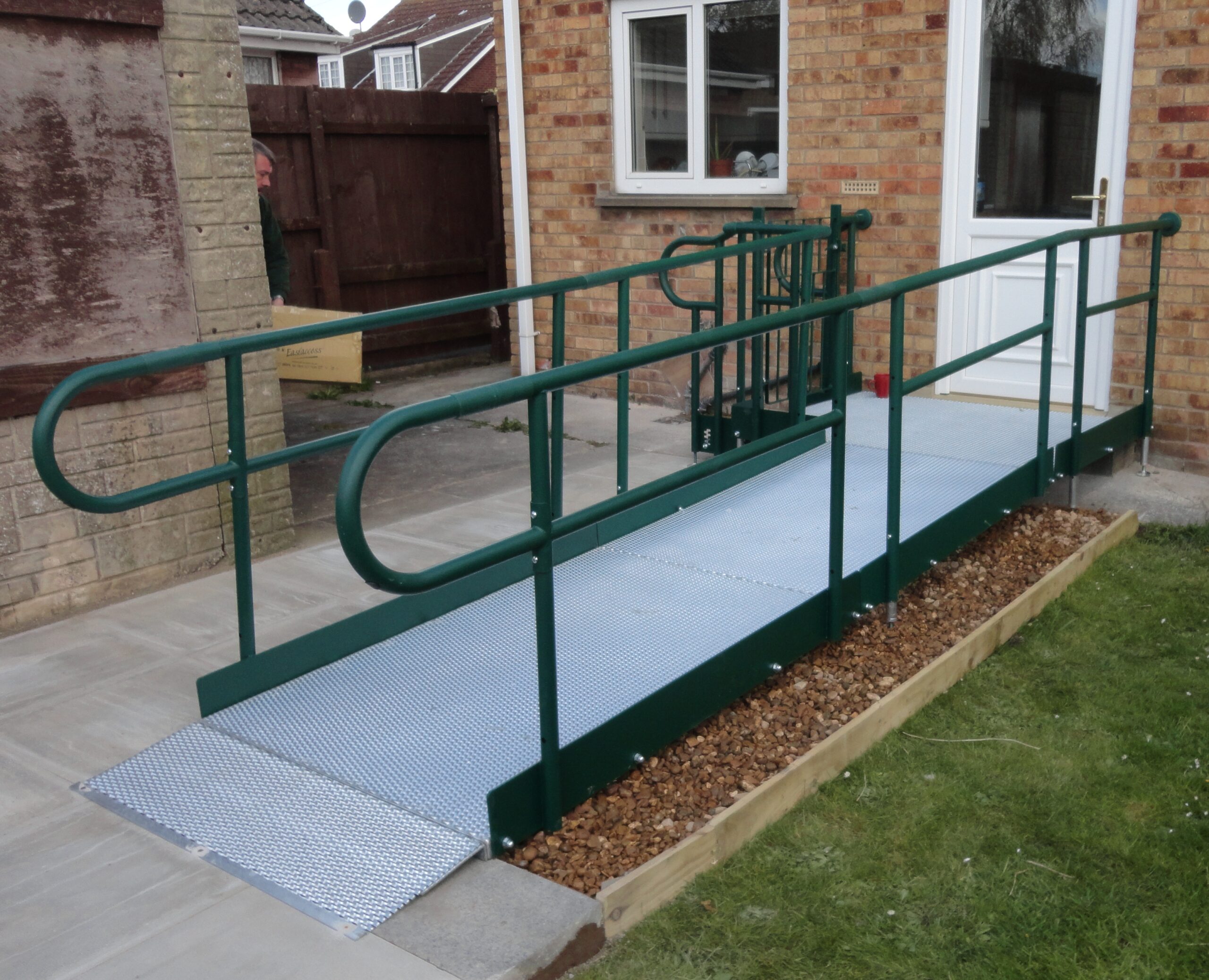
Durable construction for long-term accessibility
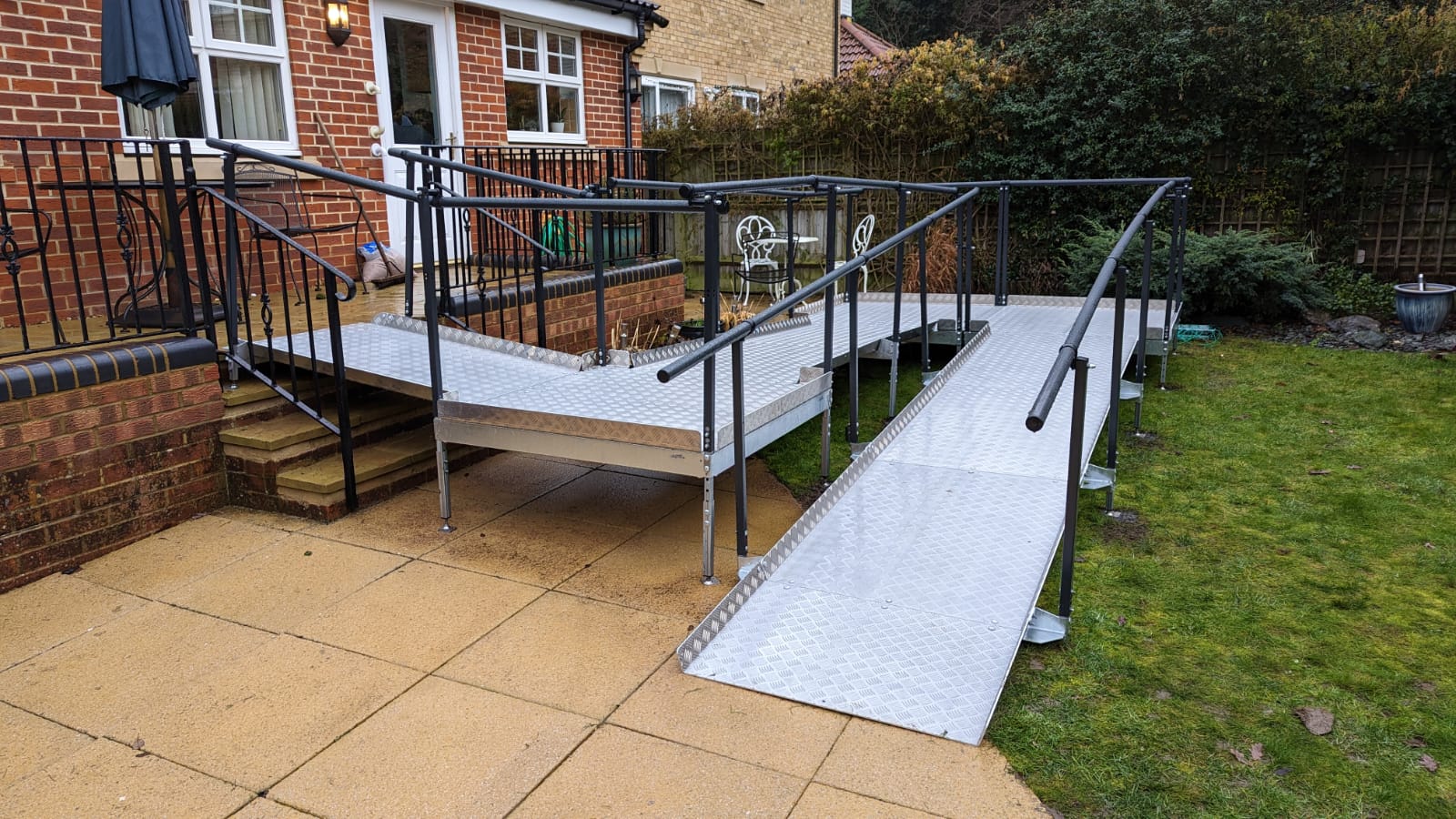
Customizable design for various home configurations

Quick-install modular ramp for immediate accessibility

Weather-resistant aluminum construction
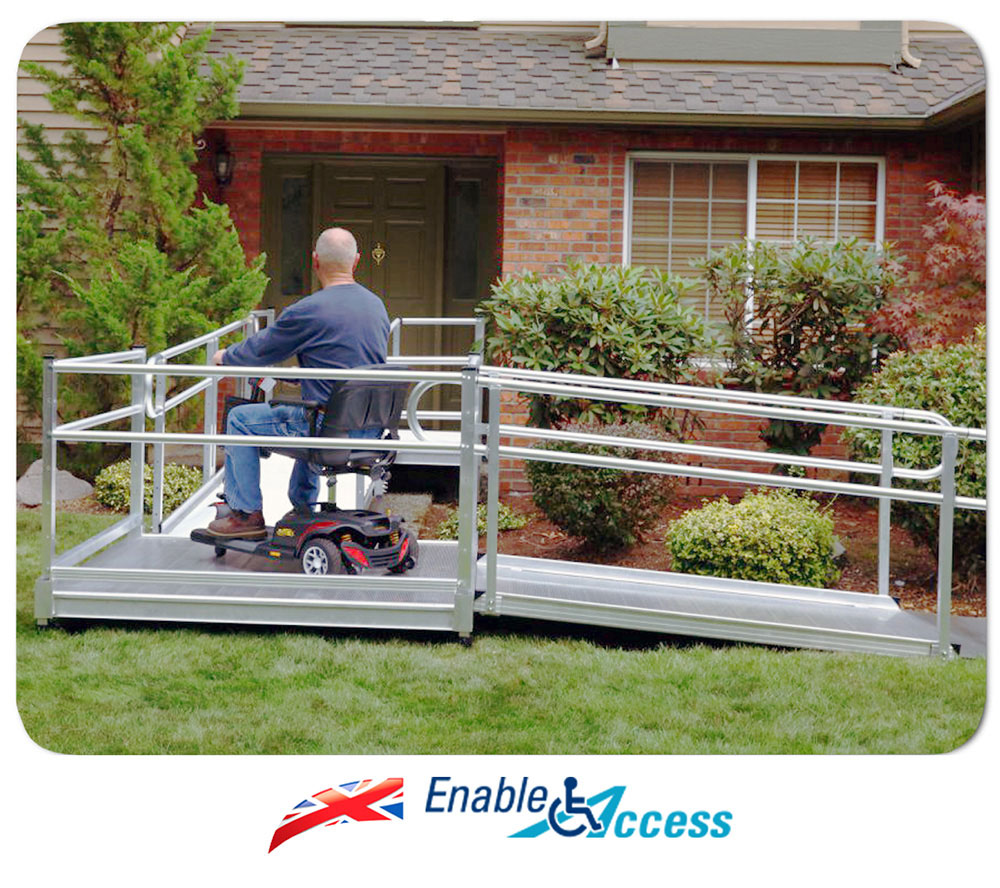
Comprehensive range for wheelchairs and scooters
Complete Guide to UK Ramp Types
1. Threshold Ramps – Doorway Solutions
Research from the Centre for Ageing Better shows that 67% of UK homes have at least one step that creates a mobility barrier. Threshold ramps eliminate these barriers with minimal installation requirements.
Key Features:
- Height range: 13mm to 150mm
- Materials: Rubber, aluminum, or composite
- Installation: Self-adhesive or bolt-down options
- Compliance: Meets DDA requirements
Cost Analysis:
- Basic rubber: £200-£400
- Aluminum adjustable: £400-£600
- Custom-fit solutions: £600-£800
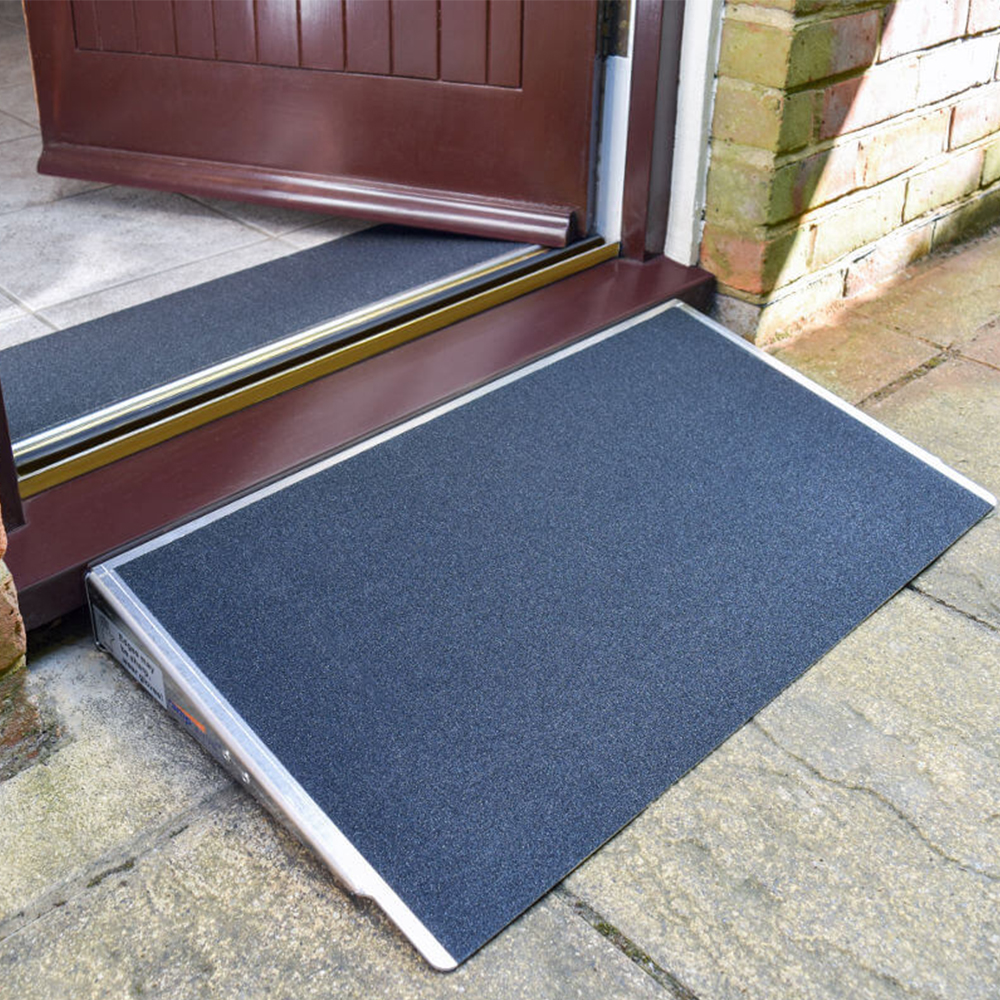
Professional threshold solution for standard doorways
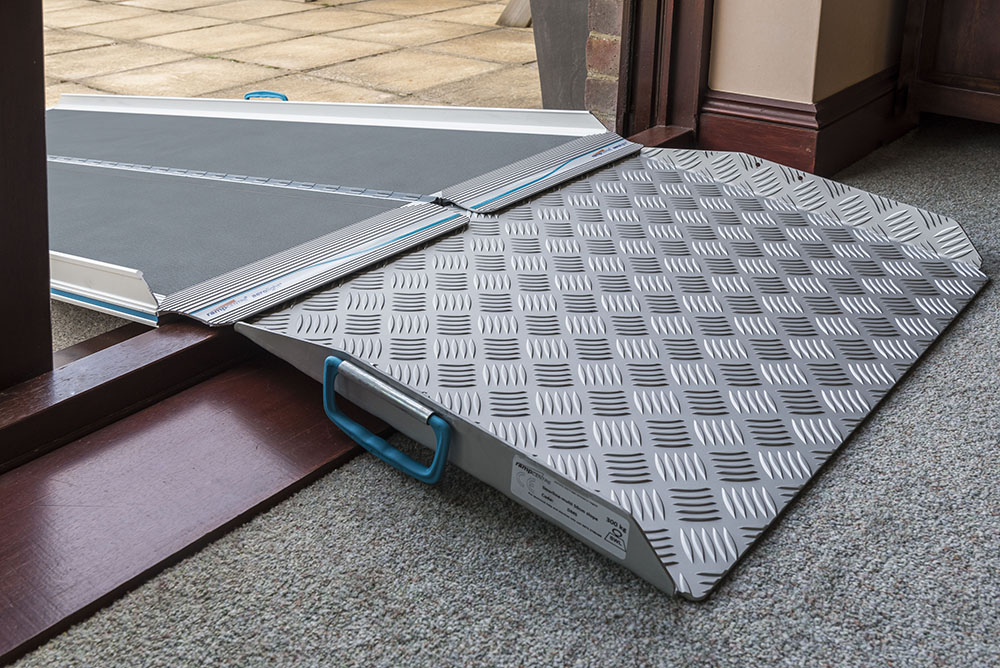
Versatile threshold ramp for various step heights
2. Portable Ramps – Flexible Access Solutions
According to mobility equipment suppliers, portable ramps account for 45% of UK ramp sales due to their versatility and cost-effectiveness. Industry analysis shows they’re ideal for users who need access at multiple locations.
Types Available:
- Folding ramps: 4ft to 10ft lengths
- Telescopic ramps: Adjustable 5ft to 12ft
- Roll-up ramps: Lightweight fabric options
- Channel ramps: For wheelchairs and scooters
Weight Capacity & Pricing:
- 270kg capacity: £300-£600
- 340kg capacity: £600-£1,200
- 450kg+ capacity: £1,200-£2,000
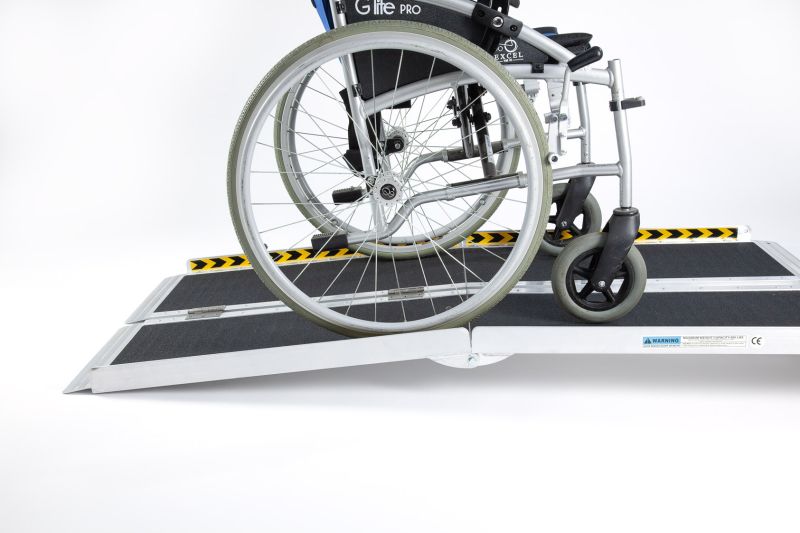
Available in 4ft to 10ft lengths with carrying handles
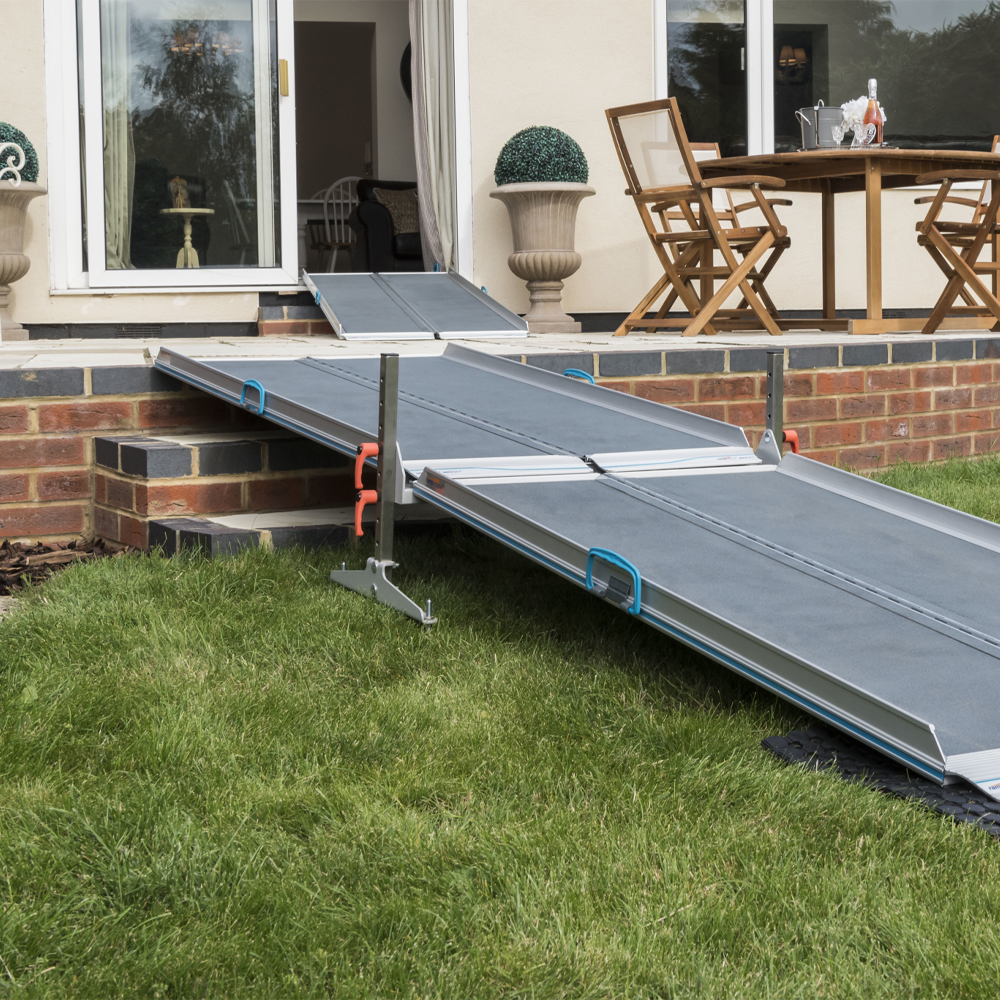
Portable kit for higher rises with platform landing
3. Modular Ramp Systems – Customizable Permanent Solutions
Data from accessibility consultants indicates that modular systems provide the best long-term value, with 89% of users reporting complete satisfaction after 5 years. These systems can be reconfigured as needs change.
Week 1: Site Assessment
Professional survey and measurements. UK Building Regulations compliance check.
Week 2-3: Design & Planning
Custom configuration design. Planning permission if required (rare for residential).
Week 4-5: Manufacturing
Components manufactured to exact specifications. Quality testing completed.
Week 6: Installation
Professional installation typically completed in 1-2 days. Full safety testing.

Aluminum construction with customizable configurations

Professional-grade aluminum with safety railings
4. Permanent Concrete Ramps – Long-term Solutions
Research from construction specialists shows that properly installed concrete ramps last 25+ years with minimal maintenance. They provide the most stable and permanent solution for UK homes.
Construction Standards:
- Gradient: Maximum 1:15 (1:12 for short runs)
- Width: Minimum 1200mm for wheelchairs
- Surface: Non-slip finish mandatory
- Drainage: Proper water runoff systems
Investment Analysis:
- Basic concrete: £3,000-£6,000
- Decorative finishes: £6,000-£10,000
- Complex configurations: £10,000-£15,000
UK Ramp Cost Analysis 2025
Detailed Cost Breakdown by Type
| Ramp Type | Initial Cost | Installation | Annual Maintenance | 5-Year Total | Best For |
|---|---|---|---|---|---|
| Threshold Ramps | £200-£800 | DIY/£100 | £20 | £300-£1,000 | Small steps, doorways |
| Portable Ramps | £300-£2,000 | None | £50 | £550-£2,250 | Temporary access, multiple locations |
| Modular Systems | £2,000-£8,000 | £500-£1,000 | £100 | £3,000-£9,500 | Permanent but adjustable access |
| Concrete Ramps | £3,000-£15,000 | Included | £75 | £3,375-£15,375 | Long-term permanent solution |
UK Safety Standards & Building Regulations
Essential Safety Requirements
According to the Health and Safety Executive, properly installed ramps reduce fall-related injuries by 73% among UK seniors. All ramps must comply with BS 8300 and DDA requirements.
Mandatory Safety Features:
- Non-slip surface texture
- Handrails both sides (ramps over 2m)
- Level landings every 10m maximum
- Edge protection barriers
- Adequate lighting provision
- Proper drainage systems
UK Building Regulations:
- Maximum gradient 1:15 (preferred)
- Minimum width 1200mm
- Handrail height 900-1000mm
- Landing size minimum 1200x1200mm
- Surface slip resistance ≥36 (wet)
- Load capacity minimum 5kN/m²
Installation Checklist
Data from certified installers shows that following this checklist reduces installation problems by 92% and ensures long-term safety.
Pre-Installation:
- Site survey completed
- Ground stability assessed
- Drainage requirements checked
- Access route planned
- Utility locations marked
During Installation:
- Level foundations confirmed
- Gradient measurements verified
- Connections properly secured
- Safety features installed
- Load testing completed
Post-Installation:
- Safety inspection passed
- User training provided
- Maintenance schedule given
- Warranty documentation
- Compliance certificate issued
Expert Insights: UK Accessibility Specialists
Industry Expert Opinions
“The UK ramp market has evolved significantly in 2025. We’re seeing increased demand for modular systems that can adapt as mobility needs change. The key is choosing solutions that grow with the user rather than requiring complete replacement.”
— Sarah Mitchell, Senior Occupational Therapist, NHS Trust
“From a construction perspective, we’re installing 40% more ramps in 2025 compared to 2023. The emphasis has shifted to weather-resistant materials and designs that complement home aesthetics while maintaining full functionality.”
— James Crawford, Accessibility Consultant, Enable Access Ltd
“Cost shouldn’t be the primary factor. We’ve seen cases where cheaper solutions required replacement within 3 years, while quality installations last 15+ years. The total cost of ownership favors investing in proper systems from the start.”
— Dr. Emma Thompson, Research Director, Centre for Ageing Better
“Technology integration is the future. We’re now incorporating smart lighting, anti-slip sensors, and maintenance alerts. These features add 20-30% to initial costs but dramatically improve safety and usability.”
— Michael Roberts, CEO, Smart Access Solutions
Step-by-Step Implementation Guide
Your Journey to Better Home Access
Research from mobility specialists shows that following this structured approach reduces project time by 35% and ensures optimal outcomes for UK homeowners.
Phase 1: Assessment & Planning (Week 1-2)
Conduct thorough mobility assessment and site evaluation.
- Measure all steps and potential access points
- Assess current and future mobility needs
- Check ground conditions and drainage
- Research local planning requirements
- Get quotes from 3+ certified installers
Phase 2: Selection & Design (Week 3-4)
Choose optimal ramp type and finalize specifications.
- Compare cost-benefit analysis of each option
- Ensure compliance with UK building regulations
- Finalize design with safety features
- Secure necessary permits or approvals
- Schedule installation with certified professionals
Phase 3: Installation (Week 5-6)
Professional installation with quality assurance.
- Site preparation and foundation work
- Ramp installation with safety features
- Testing and quality assurance checks
- User training and safety briefing
- Documentation and warranty provision
Phase 4: Ongoing Maintenance (Monthly)
Regular maintenance ensures long-term safety and functionality.
- Monthly visual inspection for damage
- Quarterly deep cleaning and surface treatment
- Annual professional safety assessment
- Prompt repair of any issues identified
- Documentation of all maintenance activities
Frequently Asked Questions
According to industry data from 2025, ramp costs vary significantly by type. Threshold ramps range from £200-£800, portable ramps cost £300-£2,000, modular systems run £2,000-£8,000, and permanent concrete ramps cost £3,000-£15,000. Installation adds 15-25% to material costs for permanent solutions. The total 5-year cost of ownership often favors higher-quality initial investments.
Most residential ramps don’t require planning permission under Permitted Development Rights. However, you need permission if the ramp extends more than 3m from the original building line, is in a conservation area, or affects a listed building. Always check with your local planning authority. Building regulations approval may be required for permanent installations over certain sizes.
Durability varies by material and maintenance. Quality aluminum ramps last 15-20 years with proper care. Concrete ramps can last 25+ years. Rubber threshold ramps typically need replacement every 5-7 years. UK weather testing shows that galvanized steel and powder-coated aluminum handle moisture best. Regular maintenance extends lifespan significantly – neglected ramps may fail in half the expected time.
UK Building Regulations recommend a maximum gradient of 1:15 (1 meter of length for every 15cm of height) for comfortable wheelchair use. Steeper gradients up to 1:12 are acceptable for short distances under 2 meters. Anything steeper requires assistance and isn’t suitable for independent use. Professional assessment helps determine the safest gradient for your specific situation and mobility requirements.
Yes, several funding options exist. Local councils offer Disabled Facilities Grants up to £30,000 for essential adaptations. Veterans may qualify for additional support through Armed Forces charities. Some housing associations provide free adaptations for tenants. Occupational therapy assessments often unlock funding. Private insurance sometimes covers ramps if they’re medically necessary. Contact your local council’s adult social services for assessment and funding guidance.
Simple threshold ramps can often be DIY projects with basic tools. However, professional installation is strongly recommended for modular systems and all permanent ramps. Professionals ensure building regulations compliance, proper foundation work, and safety standards. DIY mistakes can be dangerous and costly to fix. Insurance may not cover injuries from improperly installed ramps. The cost of professional installation (typically £500-£1,500) is worthwhile for safety and warranty protection.
Regular maintenance is crucial for safety. Monthly visual inspections should check for loose bolts, surface wear, and drainage issues. Clean surfaces quarterly with appropriate cleaners to maintain slip resistance. Annual professional inspections catch problems early. Address issues immediately – small problems become major safety hazards if ignored. Keep maintenance records for warranty and insurance purposes. Budget £75-£200 annually for professional maintenance services.
Aluminum is optimal for UK conditions – it doesn’t rust, handles temperature changes well, and maintains structural integrity in wet conditions. Galvanized steel offers strength but requires more maintenance. Composite materials provide good slip resistance but can be expensive. Avoid untreated wood in the UK climate. For surfaces, choose materials with proven slip resistance ratings (minimum 36 when wet) and UV stability for outdoor installations.
Resources & Implementation Tools
Essential Resources for UK Homeowners
Government Resources:
- Gov.UK Disabled Facilities Grant guidance
- Building Regulations Part M (Access)
- Health and Safety Executive guidelines
- Local council accessibility services
- NHS occupational therapy referrals
Professional Services:
- Certified accessibility consultants
- Approved building contractors
- Occupational therapy assessments
- Insurance advisors (adaptation coverage)
- Legal advice (planning permissions)
Your Next Steps (Implementation Timeline)
Immediate Actions (This Week):
- Measure your current steps and access points
- Document mobility challenges with photos
- Contact local council about Disabled Facilities Grants
- Request quotes from 3 certified installers
Short-term Goals (Next Month):
- Complete professional mobility assessment
- Finalize ramp type selection based on needs and budget
- Secure funding or financing arrangements
- Schedule installation with chosen contractor
Long-term Considerations (Next 6 Months):
- Complete installation and safety testing
- Establish maintenance schedule and budget
- Plan for future mobility needs and potential modifications
- Share experience with others in similar situations
Conclusion: Choosing Your Ideal Access Solution
Selecting the right access ramp for your UK home is a crucial investment in independence and safety. Industry data from 2025 shows that properly chosen and installed ramps provide an average of 15+ years of reliable service while reducing fall-related injuries by 73%.
Key Takeaways for UK Homeowners:
- Budget realistically: Quality installations cost more initially but provide better long-term value
- Plan for the future: Choose solutions that can adapt as mobility needs change
- Prioritize safety: Professional installation and compliance with UK standards are non-negotiable
- Explore funding: Government grants and local council support can significantly reduce costs
- Maintain properly: Regular maintenance extends ramp life and ensures continued safety
The UK accessibility market continues to evolve in 2025, with new technologies and materials making ramps more effective and aesthetically pleasing than ever before. Whether you choose a simple threshold ramp for £300 or invest in a comprehensive modular system for £8,000+, the right choice depends on your specific needs, budget, and long-term plans.
Remember: The best ramp is the one that provides safe, independent access while fitting your lifestyle and budget. Take time to assess your needs properly and invest in quality solutions that will serve you well for years to come.
About the Author
This comprehensive guide was researched and compiled by accessibility specialists with extensive experience in UK home adaptations and senior living solutions. For more insights on creating accessible, age-friendly homes, connect with industry experts through professional networks.

